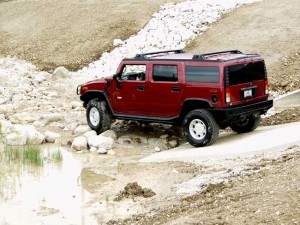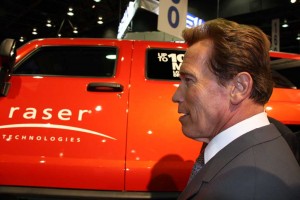
Hummer at the crossroads: GM has signed a deal with Chinese maker Tengzhong. It hopes to take over the controversial SUV brand later this year.
Life — and business — can take some strange turns. Jim Taylor is a great example. He was trained as an engineer, yet somehow wound up taking over General Motors’ flagship Cadillac division and, as general manager, leading it through its “renaissance” project, with the launch of products like the well-acclaimed CTS sedan.
But a year ago, Taylor was unexpectedly reassigned to GM’s Hummer brand, a division that serves as public enemy number one for environmentalists. Taylor’s primary job was to oversee the spinoff of the once-popular brand, one of the four divisions GM will shed as part of his Chapter 11 reorganization.
Early Tuesday morning, the automaker announced it had found a buyer. Initial intentions to keep details secret didn’t last long, as the folks at Sichuan Tengzhong Heavy Industrial Machinery Co., Ltd, in Chengdu, China, were quick to start crowing about their new acquisition. From one of the symbols of American prowess to the latest Chinese toy, Jim Taylor talked with TheDetroitBureau.com’s Bureau Chief Paul A. Eisenstein about the sale and what’s to come at Hummer, which he has agreed to stay on with when the sale is formalized, in the coming months.
 TDB: Hummer’s sale surprised some folks, who thought the brand was damaged beyond repair.
TDB: Hummer’s sale surprised some folks, who thought the brand was damaged beyond repair.
Taylor: The first thing investors look at it is cash: does it make money? We’re peddling an asset capable of turning a profit. We had to find someone willing to make a serious investment. This is not for the faint-of-heart. This is an expensive date and goes on for a long time. In the auto industry, as we’ve all seen, you can chew through a lot of cash, fast, so we were looking for a select group of investors with very deep pockets and a long-term vision.

"Governator" Arnold Schwarzenegger checks out a prototype 100 mpg Plug-in Hybrid Hummer at the recent SAE World Congress trade show.
TDB: Will Hummer, under its new owners, maintain any ties with GM?
Taylor: It’s a transition, so stepping away from GM, on Day One, we’d literally fall on our face. We needed to put in place numerous transition agreements to buy services back from GM to less us be a car company. As fast as we can stand on our own two feet, those agreements, purchasing, engineering, manufacturing and the like, fall off.
TDB: You’re bringing back some Hummer production from a plant in South Africa to a GM facility building Hummers in Shreveport, Louisiana. Will that remain a Hummer plant long-term?
Taylor: Short-term, the good news is that H3s will be made in Shreveport along with the Chevy Colorado and GMC Canyon. The question is how long do we want to leave our product in Shreveport. We’re there until the end of 2010, for sure. After that, we have a lot of choices. GM could ask us to stay. They could say get out because they’re shutting the plant. We could buy the plant. We have to figure this out.
TDB: Going forward, what sort of products will we see, and would they come from the U.S., or from China?
Taylor: As far as I can see in the next product development cycle, it would all come from here. We need to head towards CAFÉ compliance – which means smaller and more fuel efficient, or we’re dialed out. Think of the smaller H4 we were showing at the auto show and it could safely conjectured we would enter into that space.
TDB: At a recent industry trade event, a supplier you’ve worked with showed off a prototype 100 mpg Hummer plug-in hybrid. Might that be a trail you’d like to follow?
Taylor: Sure, I’d love to be in that space. Now, we have to put a pencil to that equation. It’s a big number to take on, a ground-up hybrid or electric vehicle, but it’d make a lot of sense for the Hummer brand. There’s a real paradox because the same folks who use our vehicles to explore the great outdoors often get hammered for being environmentally irresponsible, so this would help us change our image. We just have to look at the financial side to see if it’s something we can stomach.
TDB: So, if you look out five years, what are the odds you’d have some form of alternative propulsion, whether diesel, hybrid, plug-in or full electric?
Taylor: I think five years out, excellent, assured. It’s 100%. It’s a choice, then, of which one makes the most sense. It’s an economic challenge to see which one you can put your money into and get it back. It’s a little-known fact we’re just launching a diesel in the H3 in South Africa. When we bring it back to Shreveport, our intent is to make a version for the U.S., but right now, it’s not (emission law) compliant and we have to decide whether to invest the money.
TDB: Is the big H2 likely to go away?
Taylor: I don’t think so. The international desire for the H2 is even stronger than in the U.S. The vehicle sets the brand image so strongly, folks in places like Russia and China are really interested. Can it survive in its current form? Maybe not, but there’s a lot of interest in keeping the H2, as a model, running into the foreseeable future.
TDB: Would you go even smaller than the H4?
Taylor: I just walked out of a meeting with my planners and that was what we were discussing. Do we go with the H4 that you saw at the auto show or do something different? We’ll only get one shot with the rifle, and we want to make sure we hit the sweet spot. We need to figure out where to hit with fuel economy. That determines mass and a lot of other things.
TDB: There are many things that people love and look for in a Hummer, but which are also a major challenge when it comes to improving your fuel economy, like the upright windshield and big grille, both of which create a lot of aerodynamic drag. Might you have to change some of those iconic details?
Taylor: That’s the age-old dilemma, your strengths are your weaknesses. So, we’re starting with a fresh look as a new company.
TDB: You’re the brand the environmentalists love to hate. How can you change that, or do you just live with it?
Taylor: That explains why the 100 mpg prototype helps by starting to neutralize some of that. But we’ve been going around asking whether there are other successful but controversial brands that can limit themselves to a niche audience, rather than the mass market we’ve been targeting. We’re looking for the folks who like Hummers and get Hummers and are going to use them for what they’re designed to do. We’re a solution for a small group of people.
TDB: How much control will Tengzhong exercise?
Taylor: Their desire is to be very hands-off, let me run it how we want to do it, but they supply the cash. They aren’t in the car business, so they won’t come and pretend they’re smarter than us, which is the risk when you’re acquired by another car company.
TDB: Where will your headquarters be?
Taylor: It won’t move from the United States. But right now I have to evaluate the economics of being in Michigan or going to one of the other states that throws a better package at us. I have to look at it coldly, as a businessman. I’m talking to Michigan and a couple of other states.
